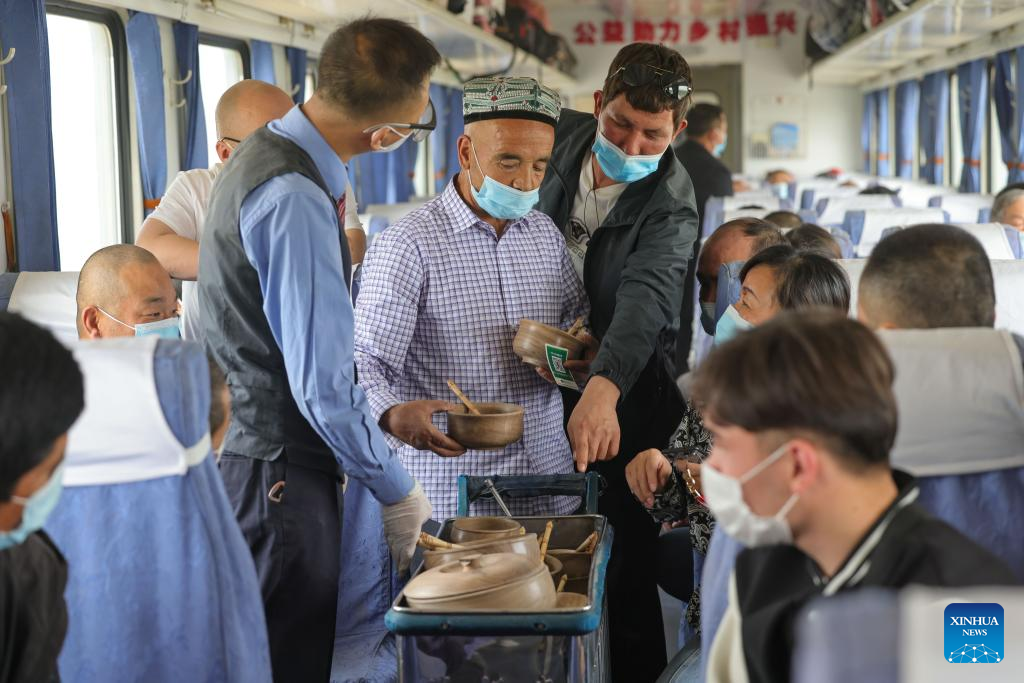
A craftsman sells his handicrafts aboard a slow train running in northwest China's Xinjiang Uygur Autonomous Region, April 28, 2022.
As bullet trains zoom through stations in many parts of China, the seemingly outdated, rumbling slow-speed trains have continued to serve residents of remote areas with stable ticket prices and services.
Though home to the world's most developed high-speed railway network, China still regularly operates 81 slow train services. The trains 7556/7557 and 7558/7555, running between Xinjiang's capital Urumqi and Hotan, are typical examples.
The whole journey of the trains is 1,960 km, with 66 stops along the way. Since the trains' operation in June 2011, the fares have remained affordable for locals to help them shake off poverty and embrace better lives. People adore taking the slow-speed trains to carry goods to markets, send children to schools, and head for megacities as migrant workers.
The slow trains, carrying the hope of local people, move forward steadily and surely with a unique rhythm that has not changed for years. (Xinhua/Ding Lei)

Passengers take selfies aboard a slow train bound for Urumqi in northwest China's Xinjiang Uygur Autonomous Region, April 29, 2022.
As bullet trains zoom through stations in many parts of China, the seemingly outdated, rumbling slow-speed trains have continued to serve residents of remote areas with stable ticket prices and services.
Though home to the world's most developed high-speed railway network, China still regularly operates 81 slow train services. The trains 7556/7557 and 7558/7555, running between Xinjiang's capital Urumqi and Hotan, are typical examples.
The whole journey of the trains is 1,960 km, with 66 stops along the way. Since the trains' operation in June 2011, the fares have remained affordable for locals to help them shake off poverty and embrace better lives. People adore taking the slow-speed trains to carry goods to markets, send children to schools, and head for megacities as migrant workers.
The slow trains, carrying the hope of local people, move forward steadily and surely with a unique rhythm that has not changed for years. (Xinhua/Ding Lei)

This combo photo shows (top) a layer of sand on the junction of two train carriages as the train runs though areas hit by the ravaging wind-blown sand on April 27, 2022, and (bottom) a train steward cleaning the sand on the junction of two train carriages of a slow train running in northwest China's Xinjiang Uygur Autonomous Region, April 27, 2022.
As bullet trains zoom through stations in many parts of China, the seemingly outdated, rumbling slow-speed trains have continued to serve residents of remote areas with stable ticket prices and services.
Though home to the world's most developed high-speed railway network, China still regularly operates 81 slow train services. The trains 7556/7557 and 7558/7555, running between Xinjiang's capital Urumqi and Hotan, are typical examples.
The whole journey of the trains is 1,960 km, with 66 stops along the way. Since the trains' operation in June 2011, the fares have remained affordable for locals to help them shake off poverty and embrace better lives. People adore taking the slow-speed trains to carry goods to markets, send children to schools, and head for megacities as migrant workers.
The slow trains, carrying the hope of local people, move forward steadily and surely with a unique rhythm that has not changed for years. (Xinhua/Ding Lei)

A senior passenger talks with a kid aboard a slow train bound for Hotan in northwest China's Xinjiang Uygur Autonomous Region, April 27, 2022.
As bullet trains zoom through stations in many parts of China, the seemingly outdated, rumbling slow-speed trains have continued to serve residents of remote areas with stable ticket prices and services.
Though home to the world's most developed high-speed railway network, China still regularly operates 81 slow train services. The trains 7556/7557 and 7558/7555, running between Xinjiang's capital Urumqi and Hotan, are typical examples.
The whole journey of the trains is 1,960 km, with 66 stops along the way. Since the trains' operation in June 2011, the fares have remained affordable for locals to help them shake off poverty and embrace better lives. People adore taking the slow-speed trains to carry goods to markets, send children to schools, and head for megacities as migrant workers.
The slow trains, carrying the hope of local people, move forward steadily and surely with a unique rhythm that has not changed for years. (Xinhua/Ding Lei)
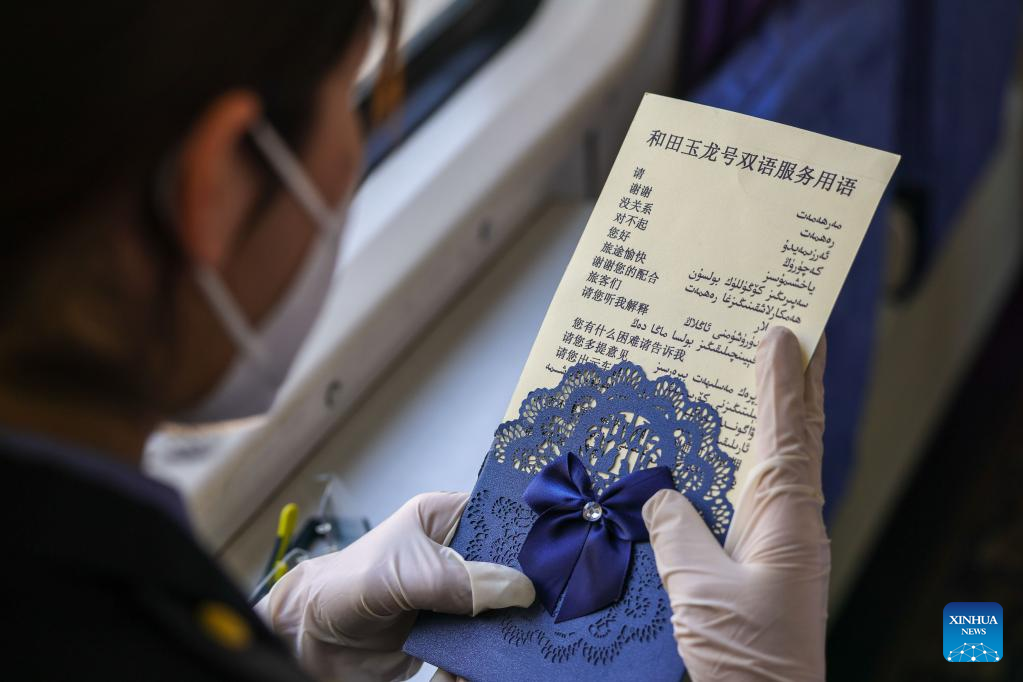
A train attendant studies the reference for Uygur language and Mandarin Chinese translation aboard a slow train running in northwest China's Xinjiang Uygur Autonomous Region, April 29, 2022.
As bullet trains zoom through stations in many parts of China, the seemingly outdated, rumbling slow-speed trains have continued to serve residents of remote areas with stable ticket prices and services.
Though home to the world's most developed high-speed railway network, China still regularly operates 81 slow train services. The trains 7556/7557 and 7558/7555, running between Xinjiang's capital Urumqi and Hotan, are typical examples.
The whole journey of the trains is 1,960 km, with 66 stops along the way. Since the trains' operation in June 2011, the fares have remained affordable for locals to help them shake off poverty and embrace better lives. People adore taking the slow-speed trains to carry goods to markets, send children to schools, and head for megacities as migrant workers.
The slow trains, carrying the hope of local people, move forward steadily and surely with a unique rhythm that has not changed for years. (Xinhua/Ding Lei)
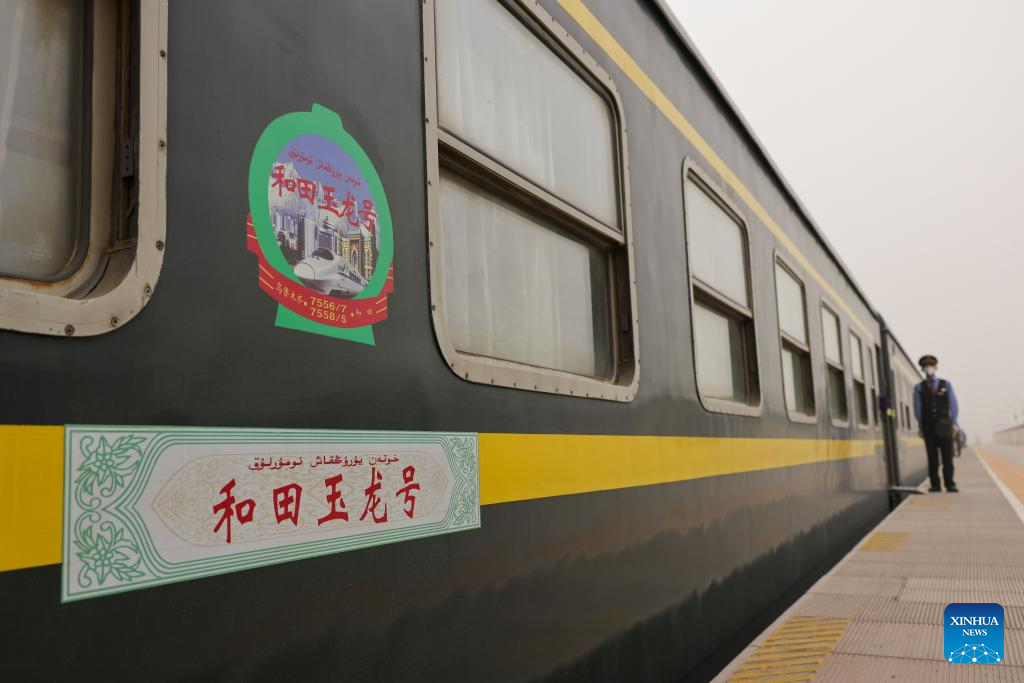
A train steward waits for passengers on the platform beside a slow train bound for Hotan in northwest China's Xinjiang Uygur Autonomous Region, April 27, 2022.
As bullet trains zoom through stations in many parts of China, the seemingly outdated, rumbling slow-speed trains have continued to serve residents of remote areas with stable ticket prices and services.
Though home to the world's most developed high-speed railway network, China still regularly operates 81 slow train services. The trains 7556/7557 and 7558/7555, running between Xinjiang's capital Urumqi and Hotan, are typical examples.
The whole journey of the trains is 1,960 km, with 66 stops along the way. Since the trains' operation in June 2011, the fares have remained affordable for locals to help them shake off poverty and embrace better lives. People adore taking the slow-speed trains to carry goods to markets, send children to schools, and head for megacities as migrant workers.
The slow trains, carrying the hope of local people, move forward steadily and surely with a unique rhythm that has not changed for years. (Xinhua/Ding Lei)
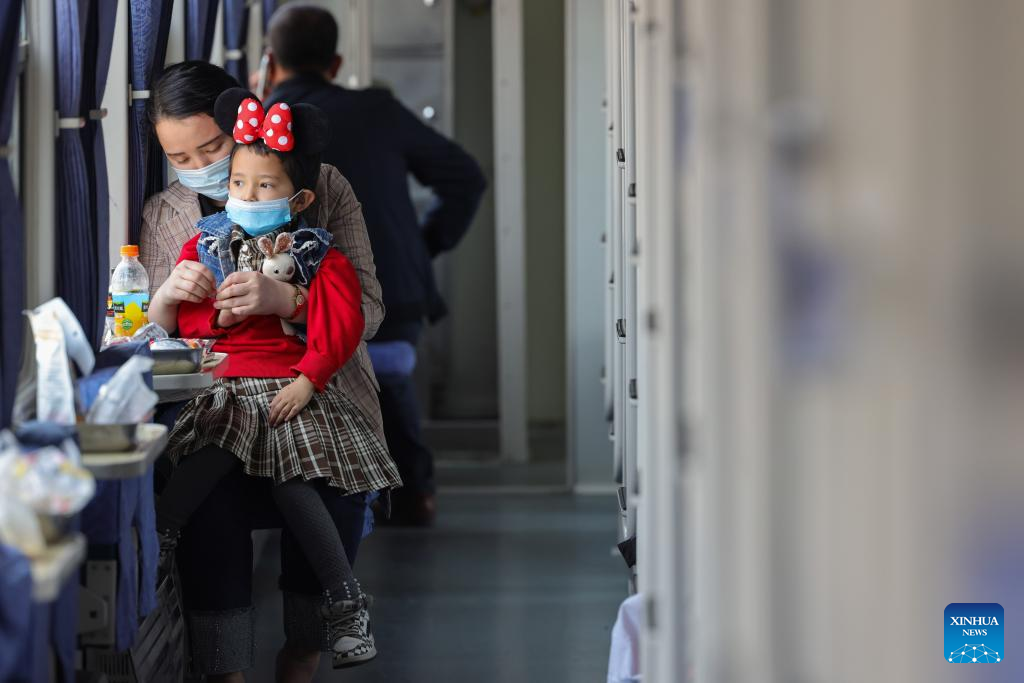
Passengers take a rest aboard a slow train bound for Hotan in northwest China's Xinjiang Uygur Autonomous Region, April 27, 2022.
As bullet trains zoom through stations in many parts of China, the seemingly outdated, rumbling slow-speed trains have continued to serve residents of remote areas with stable ticket prices and services.
Though home to the world's most developed high-speed railway network, China still regularly operates 81 slow train services. The trains 7556/7557 and 7558/7555, running between Xinjiang's capital Urumqi and Hotan, are typical examples.
The whole journey of the trains is 1,960 km, with 66 stops along the way. Since the trains' operation in June 2011, the fares have remained affordable for locals to help them shake off poverty and embrace better lives. People adore taking the slow-speed trains to carry goods to markets, send children to schools, and head for megacities as migrant workers.
The slow trains, carrying the hope of local people, move forward steadily and surely with a unique rhythm that has not changed for years. (Xinhua/Ding Lei)

A train conductor learns about the health condition of a passenger with disability aboard a slow train bound for Hotan in northwest China's Xinjiang Uygur Autonomous Region, April 27, 2022.
As bullet trains zoom through stations in many parts of China, the seemingly outdated, rumbling slow-speed trains have continued to serve residents of remote areas with stable ticket prices and services.
Though home to the world's most developed high-speed railway network, China still regularly operates 81 slow train services. The trains 7556/7557 and 7558/7555, running between Xinjiang's capital Urumqi and Hotan, are typical examples.
The whole journey of the trains is 1,960 km, with 66 stops along the way. Since the trains' operation in June 2011, the fares have remained affordable for locals to help them shake off poverty and embrace better lives. People adore taking the slow-speed trains to carry goods to markets, send children to schools, and head for megacities as migrant workers.
The slow trains, carrying the hope of local people, move forward steadily and surely with a unique rhythm that has not changed for years. (Xinhua/Ding Lei)
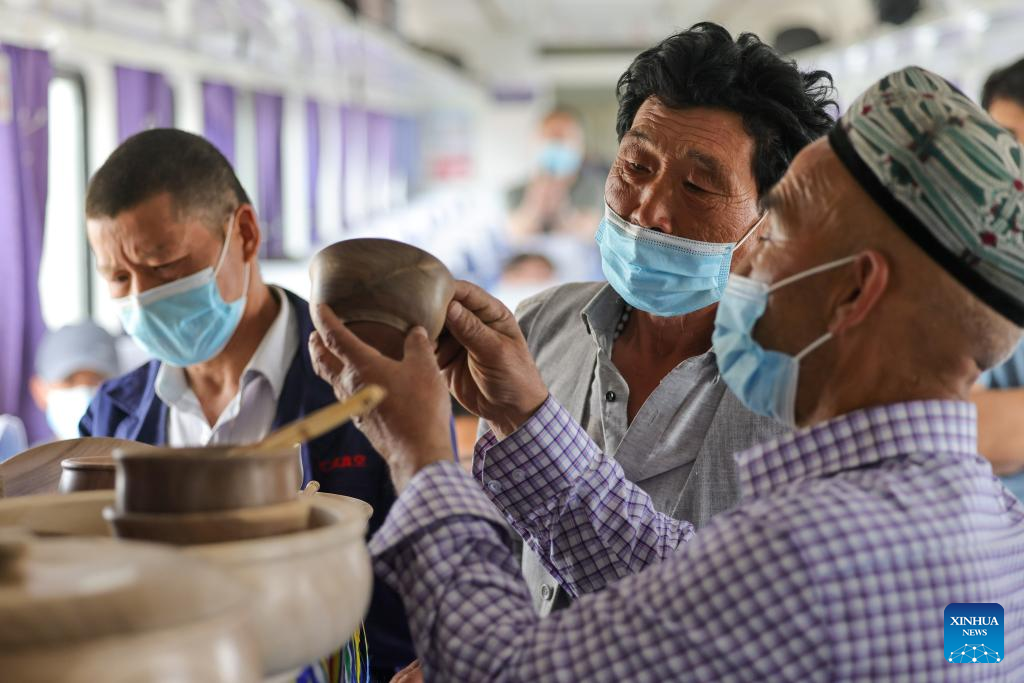
Passengers choose handicrafts aboard a slow train running in northwest China's Xinjiang Uygur Autonomous Region, April 28, 2022.
As bullet trains zoom through stations in many parts of China, the seemingly outdated, rumbling slow-speed trains have continued to serve residents of remote areas with stable ticket prices and services.
Though home to the world's most developed high-speed railway network, China still regularly operates 81 slow train services. The trains 7556/7557 and 7558/7555, running between Xinjiang's capital Urumqi and Hotan, are typical examples.
The whole journey of the trains is 1,960 km, with 66 stops along the way. Since the trains' operation in June 2011, the fares have remained affordable for locals to help them shake off poverty and embrace better lives. People adore taking the slow-speed trains to carry goods to markets, send children to schools, and head for megacities as migrant workers.
The slow trains, carrying the hope of local people, move forward steadily and surely with a unique rhythm that has not changed for years. (Xinhua/Ding Lei)
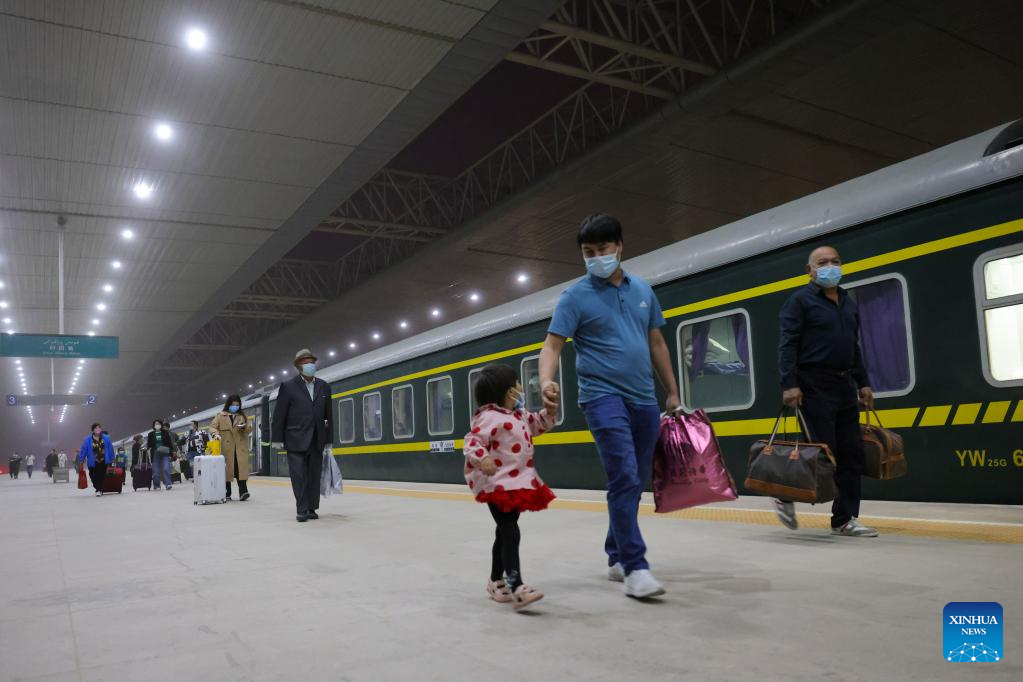
Passengers get off a slow train in Hotan Railway Station in Hotan, northwest China's Xinjiang Uygur Autonomous Region, April 27, 2022.
As bullet trains zoom through stations in many parts of China, the seemingly outdated, rumbling slow-speed trains have continued to serve residents of remote areas with stable ticket prices and services.
Though home to the world's most developed high-speed railway network, China still regularly operates 81 slow train services. The trains 7556/7557 and 7558/7555, running between Xinjiang's capital Urumqi and Hotan, are typical examples.
The whole journey of the trains is 1,960 km, with 66 stops along the way. Since the trains' operation in June 2011, the fares have remained affordable for locals to help them shake off poverty and embrace better lives. People adore taking the slow-speed trains to carry goods to markets, send children to schools, and head for megacities as migrant workers.
The slow trains, carrying the hope of local people, move forward steadily and surely with a unique rhythm that has not changed for years. (Xinhua/Ding Lei)
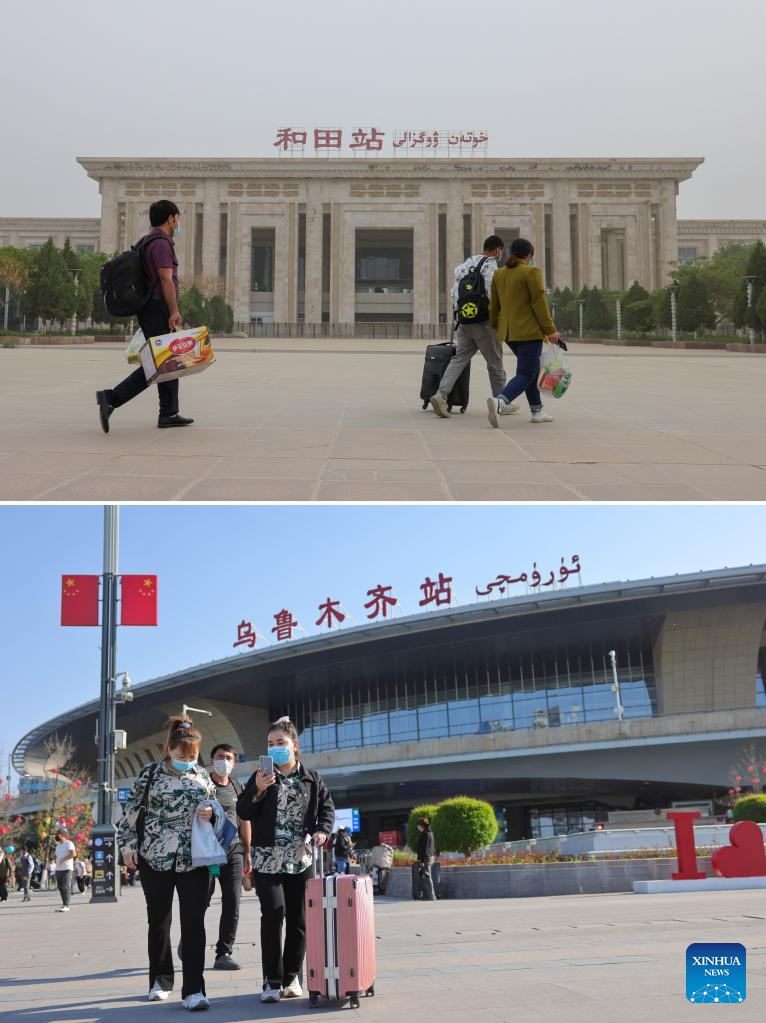
This combo photo shows (top) passengers walking to Hotan Railway Station in Hotan, northwest China's Xinjiang Uygur Autonomous Region, April 28, 2022 , and (bottom) passengers walking out of Urumqi Railway Station in Urumqi, northwest China's Xinjiang Uygur Autonomous Region, April 29, 2022,
As bullet trains zoom through stations in many parts of China, the seemingly outdated, rumbling slow-speed trains have continued to serve residents of remote areas with stable ticket prices and services.
Though home to the world's most developed high-speed railway network, China still regularly operates 81 slow train services. The trains 7556/7557 and 7558/7555, running between Xinjiang's capital Urumqi and Hotan, are typical examples.
The whole journey of the trains is 1,960 km, with 66 stops along the way. Since the trains' operation in June 2011, the fares have remained affordable for locals to help them shake off poverty and embrace better lives. People adore taking the slow-speed trains to carry goods to markets, send children to schools, and head for megacities as migrant workers.
The slow trains, carrying the hope of local people, move forward steadily and surely with a unique rhythm that has not changed for years. (Xinhua/Ding Lei)
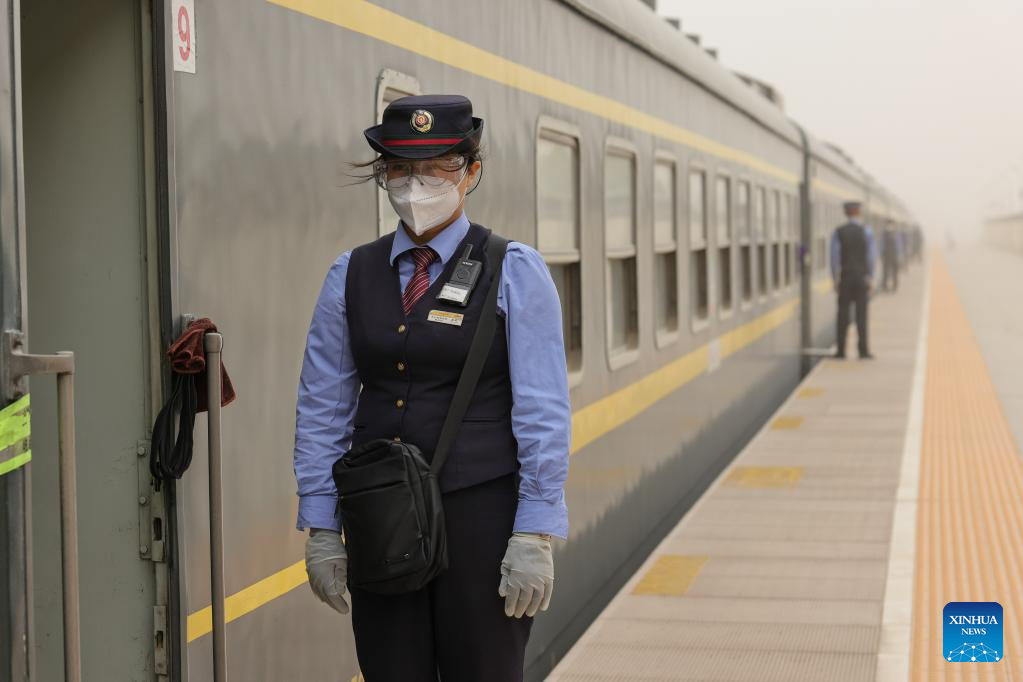
Train attendants wait for passengers on the platform beside a slow train bound for Hotan in northwest China's Xinjiang Uygur Autonomous Region, April 27, 2022.
As bullet trains zoom through stations in many parts of China, the seemingly outdated, rumbling slow-speed trains have continued to serve residents of remote areas with stable ticket prices and services.
Though home to the world's most developed high-speed railway network, China still regularly operates 81 slow train services. The trains 7556/7557 and 7558/7555, running between Xinjiang's capital Urumqi and Hotan, are typical examples.
The whole journey of the trains is 1,960 km, with 66 stops along the way. Since the trains' operation in June 2011, the fares have remained affordable for locals to help them shake off poverty and embrace better lives. People adore taking the slow-speed trains to carry goods to markets, send children to schools, and head for megacities as migrant workers.
The slow trains, carrying the hope of local people, move forward steadily and surely with a unique rhythm that has not changed for years. (Xinhua/Ding Lei)

A passenger takes photos of scenery along the rail route aboard a slow train bound for Urumqi in northwest China's Xinjiang Uygur Autonomous Region, April 29, 2022.
As bullet trains zoom through stations in many parts of China, the seemingly outdated, rumbling slow-speed trains have continued to serve residents of remote areas with stable ticket prices and services.
Though home to the world's most developed high-speed railway network, China still regularly operates 81 slow train services. The trains 7556/7557 and 7558/7555, running between Xinjiang's capital Urumqi and Hotan, are typical examples.
The whole journey of the trains is 1,960 km, with 66 stops along the way. Since the trains' operation in June 2011, the fares have remained affordable for locals to help them shake off poverty and embrace better lives. People adore taking the slow-speed trains to carry goods to markets, send children to schools, and head for megacities as migrant workers.
The slow trains, carrying the hope of local people, move forward steadily and surely with a unique rhythm that has not changed for years. (Xinhua/Ding Lei)
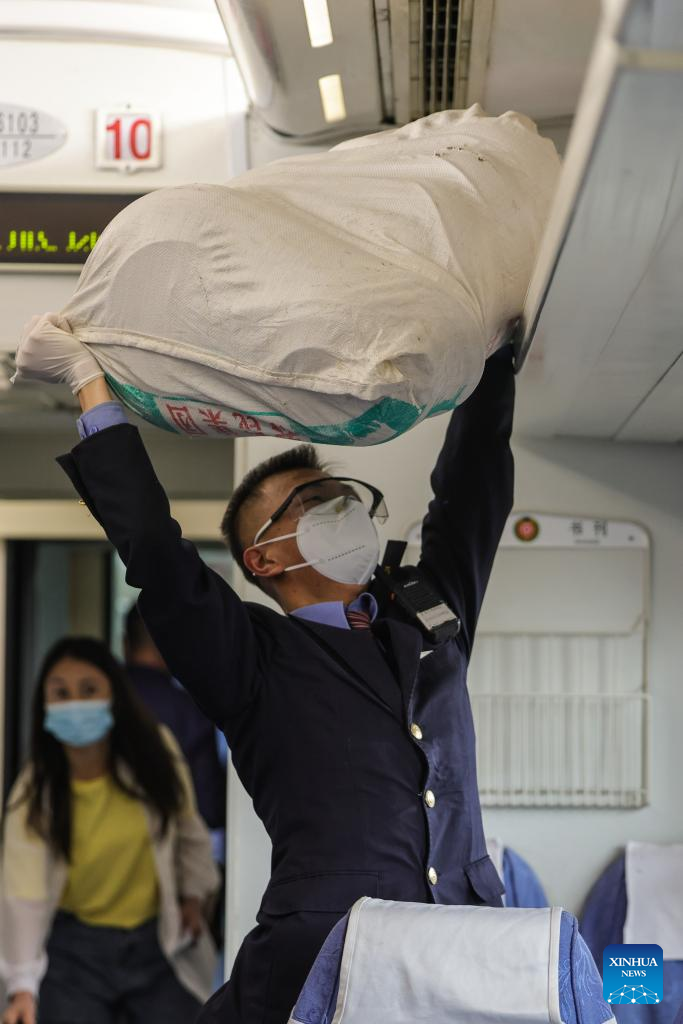
A train steward helps a passenger put the luggage in place aboard a slow train bound for Urumqi in northwest China's Xinjiang Uygur Autonomous Region, April 28, 2022.
As bullet trains zoom through stations in many parts of China, the seemingly outdated, rumbling slow-speed trains have continued to serve residents of remote areas with stable ticket prices and services.
Though home to the world's most developed high-speed railway network, China still regularly operates 81 slow train services. The trains 7556/7557 and 7558/7555, running between Xinjiang's capital Urumqi and Hotan, are typical examples.
The whole journey of the trains is 1,960 km, with 66 stops along the way. Since the trains' operation in June 2011, the fares have remained affordable for locals to help them shake off poverty and embrace better lives. People adore taking the slow-speed trains to carry goods to markets, send children to schools, and head for megacities as migrant workers.
The slow trains, carrying the hope of local people, move forward steadily and surely with a unique rhythm that has not changed for years. (Xinhua/Ding Lei)

Children play toys aboard a slow train bound for Hotan in northwest China's Xinjiang Uygur Autonomous Region, April 27, 2022.
As bullet trains zoom through stations in many parts of China, the seemingly outdated, rumbling slow-speed trains have continued to serve residents of remote areas with stable ticket prices and services.
Though home to the world's most developed high-speed railway network, China still regularly operates 81 slow train services. The trains 7556/7557 and 7558/7555, running between Xinjiang's capital Urumqi and Hotan, are typical examples.
The whole journey of the trains is 1,960 km, with 66 stops along the way. Since the trains' operation in June 2011, the fares have remained affordable for locals to help them shake off poverty and embrace better lives. People adore taking the slow-speed trains to carry goods to markets, send children to schools, and head for megacities as migrant workers.
The slow trains, carrying the hope of local people, move forward steadily and surely with a unique rhythm that has not changed for years. (Xinhua/Ding Lei)
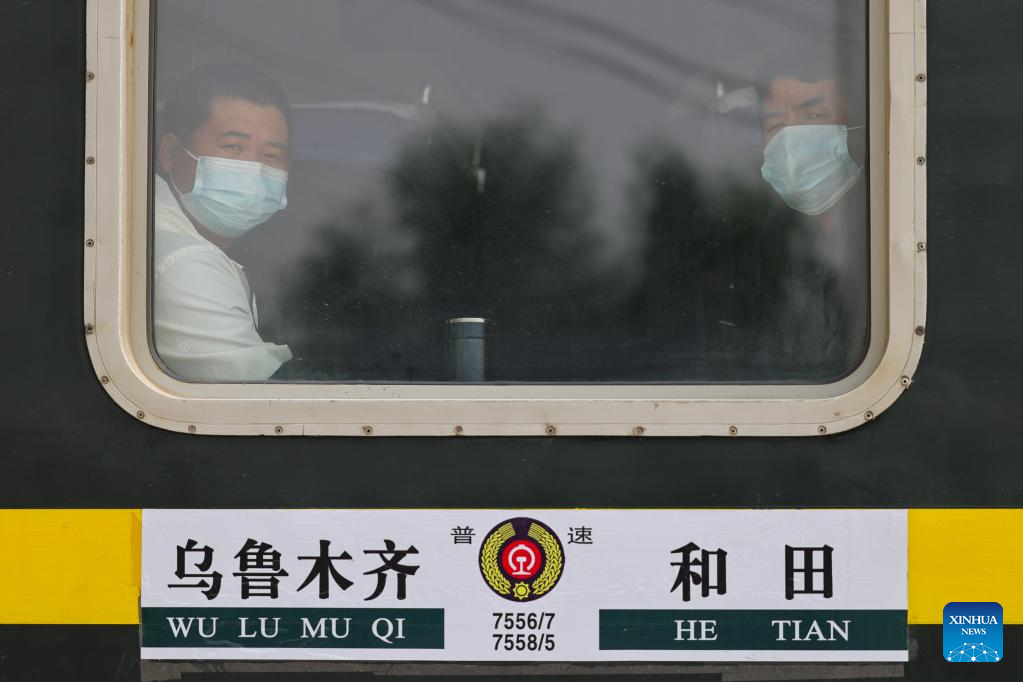
Passengers look out of a window aboard a slow train bound for Urumqi in northwest China's Xinjiang Uygur Autonomous Region, April 28, 2022.
As bullet trains zoom through stations in many parts of China, the seemingly outdated, rumbling slow-speed trains have continued to serve residents of remote areas with stable ticket prices and services.
Though home to the world's most developed high-speed railway network, China still regularly operates 81 slow train services. The trains 7556/7557 and 7558/7555, running between Xinjiang's capital Urumqi and Hotan, are typical examples.
The whole journey of the trains is 1,960 km, with 66 stops along the way. Since the trains' operation in June 2011, the fares have remained affordable for locals to help them shake off poverty and embrace better lives. People adore taking the slow-speed trains to carry goods to markets, send children to schools, and head for megacities as migrant workers.
The slow trains, carrying the hope of local people, move forward steadily and surely with a unique rhythm that has not changed for years. (Xinhua/Ding Lei)

A passenger plays the guitar aboard a slow train bound for Hotan in northwest China's Xinjiang Uygur Autonomous Region, April 27, 2022.
As bullet trains zoom through stations in many parts of China, the seemingly outdated, rumbling slow-speed trains have continued to serve residents of remote areas with stable ticket prices and services.
Though home to the world's most developed high-speed railway network, China still regularly operates 81 slow train services. The trains 7556/7557 and 7558/7555, running between Xinjiang's capital Urumqi and Hotan, are typical examples.
The whole journey of the trains is 1,960 km, with 66 stops along the way. Since the trains' operation in June 2011, the fares have remained affordable for locals to help them shake off poverty and embrace better lives. People adore taking the slow-speed trains to carry goods to markets, send children to schools, and head for megacities as migrant workers.
The slow trains, carrying the hope of local people, move forward steadily and surely with a unique rhythm that has not changed for years. (Xinhua/Ding Lei)
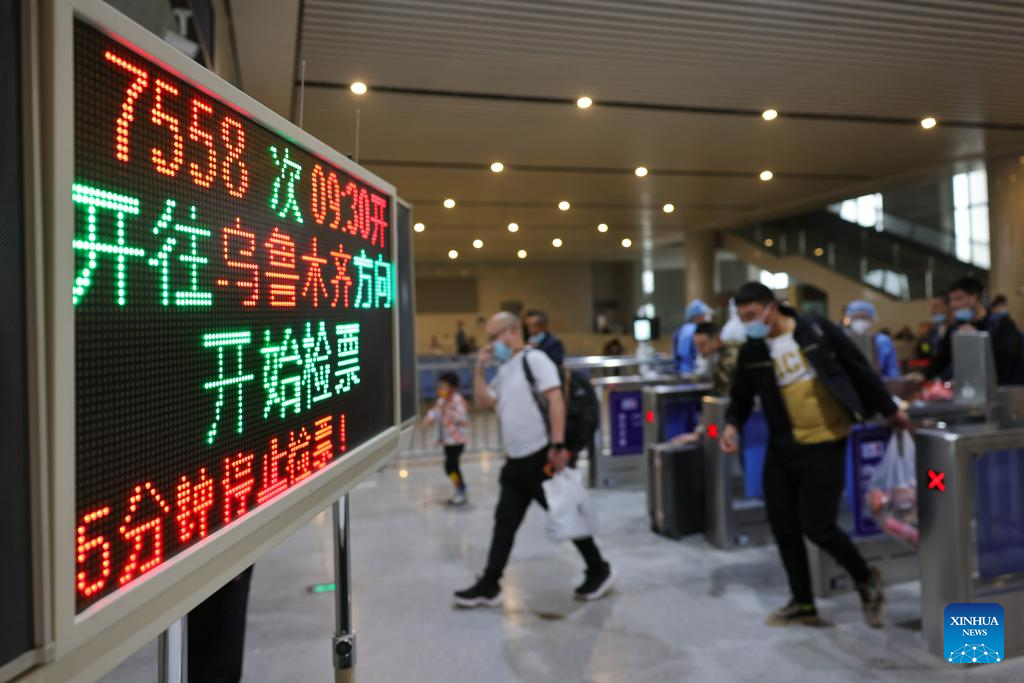
Passengers have their tickets checked to board the train 7558 bound for Urumqi in Hotan Railway Station in Hotan, northwest China's Xinjiang Uygur Autonomous Region, April 28, 2022.
As bullet trains zoom through stations in many parts of China, the seemingly outdated, rumbling slow-speed trains have continued to serve residents of remote areas with stable ticket prices and services.
Though home to the world's most developed high-speed railway network, China still regularly operates 81 slow train services. The trains 7556/7557 and 7558/7555, running between Xinjiang's capital Urumqi and Hotan, are typical examples.
The whole journey of the trains is 1,960 km, with 66 stops along the way. Since the trains' operation in June 2011, the fares have remained affordable for locals to help them shake off poverty and embrace better lives. People adore taking the slow-speed trains to carry goods to markets, send children to schools, and head for megacities as migrant workers.
The slow trains, carrying the hope of local people, move forward steadily and surely with a unique rhythm that has not changed for years. (Xinhua/Ding Lei)



